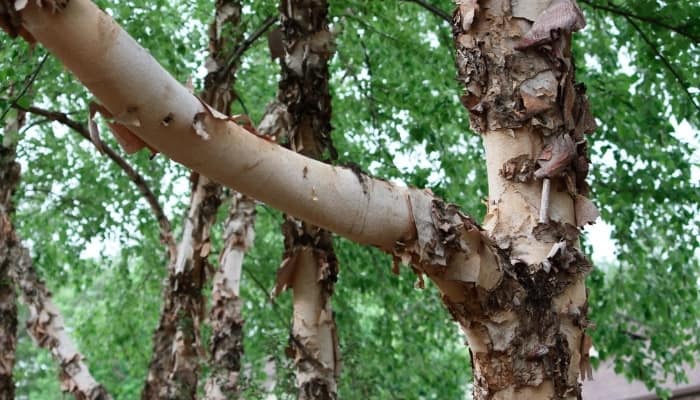Take a moment to closely observe the trees on your park or woodland stroll, and you’ll discover the abundance of stunning textures and patterns concealed within the bark.
These rough, craggy features not only add character, but some shaggy bark types even burn longer, making them excellent choices for firewood.
Let’s look at 12 shaggy bark trees and learn how to identify them!
1. Shagbark Hickory
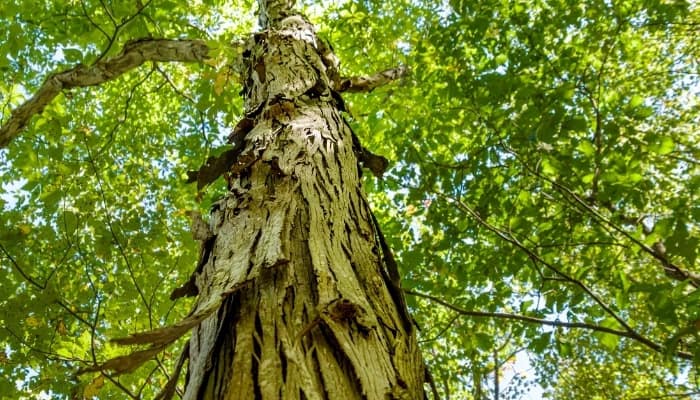
This slow-growing deciduous tree thrives in USDA Grow Zones 4-8 and can be spotted in woodlands, wooded slopes, and along the edges of limestone glades.
How To Identify
- Its grayish-brown bark is heavily textured, jutting out in large strips and flakes as it peels away with age.
- Trees have a single tall trunk with an oval-shaped crown of upward and downward-facing branches.
- Its dark green leaves have pale-green undersides with finely toothed edges and measure 8-16 inches long, each one in a group of 5-7 leaflets to each side of a twig.
- In fall, the foliage turns bright yellow/golden brown.
- Shagbark hickory trees grow between 70-90 feet high and produce long dangling green flower clusters between April and June known as catkins, followed by fruit that is encased in rounded bright-green husks measuring 1-2 inches in diameter.
2. Paper Birch
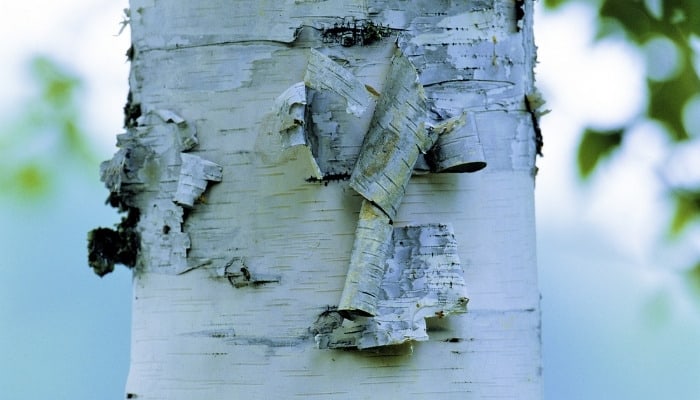
Deciduous paper birches grow along riverbanks, floodplain sites, and avalanche tracks and grow best in Zones 2-7.
How To Identify
- Its delicate pale-white bark is scored with many dark horizontal lines or “lenticels,” and narrow layers peel off at maturity, revealing orange inner bark.
- Trees have a slender single or multi-stemmed habit with rounded canopies and low-level branches.
- Its dark-green spear-shaped leaves measure 4 inches long and have fine, irregular toothed edges.
- Foliage turns bright yellow in the fall.
- Paper birches reach between 50-70 feet high and send out pendulous yellow catkins around April-May.
3. River Birch
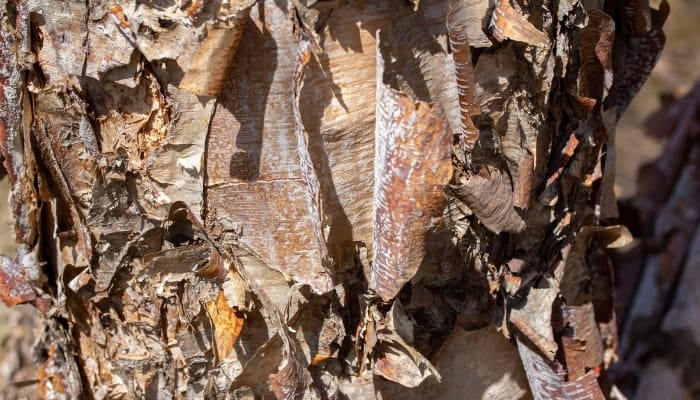
River birches are deciduous trees that prosper in Zones 4-9 and are normally found along streams, riverbanks, and dry swamp areas.
How To Identify
- Bark begins a smooth salmon to creamy-brown color at immaturity before exfoliating in ragged papery flakes, becoming scaly and grayish-brown with age.
- Trees grow in a single or multi-trunk upright clumping habit with a dense, irregular canopy shape.
- Its glossy and dark-green diamond-shaped leaves measure 1-3 inches long with irregularly serrated edges.
- These leaves transform to bright buttery yellow in the fall.
- River birches grow between 40-90 feet high and send out 2- to 3-inch long crimson-green catkins around late-summer.
4. Yellow Birch
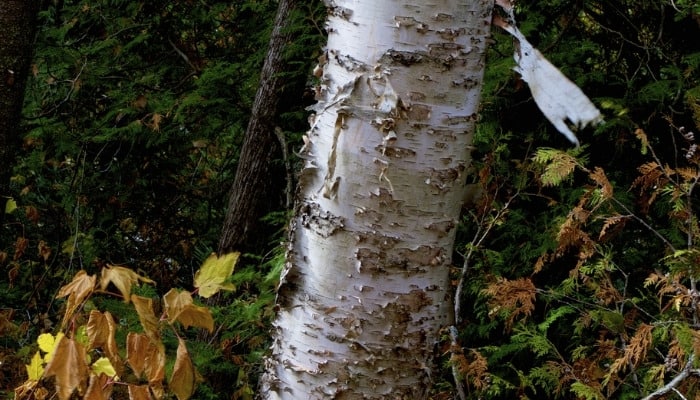
Deciduous yellow birch trees fare best in Zones 3-7 and are typically found in moist marsh regions and alongside streams.
How To Identify
- Yellow birch has amber-bronze bark with white horizontal score lines. With age, the bark curls off in coarse ringlets, though mature trees retain some smooth bark at the base. (Hint: if you scratch off the bark and smell wintergreen, you know you have a yellow birch!).
- Trees are slender with a wide, rounded habit of drooping branches.
- Its oval emerald-green leaves measure 4 inches long and have fine-toothed edges with ridged vein detail.
- Leaves turn a lime-yellow shade in fall.
- These reach between 70-100 feet high and produce clusters of 5-8 brownish-yellow catkins around May in drooping (male) and upright (female) forms.
5. American Sycamore
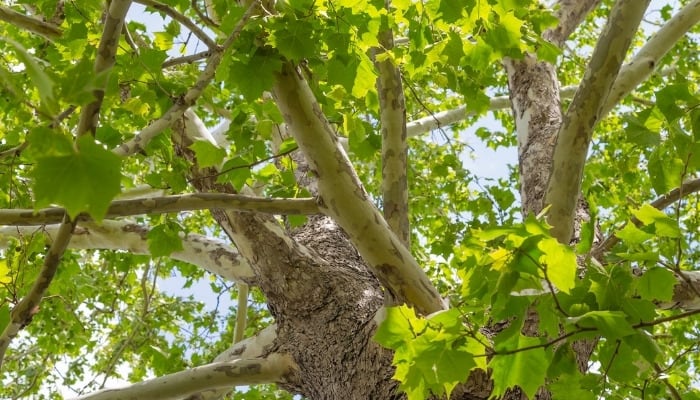
These deciduous trees can be found in woodlands and along streams and riverbanks and tend to fare best in Zones 4-9.
How To Identify
- Bark begins life a dark brownish gray with a rough honeycomb, puzzle-piece texture. With age this flakes off in patches, revealing a distinctive camo-like pattern of tan/cream/dark-green smooth inner bark.
- Trees have tall trunks with large spreading branches forming an open, reaching canopy.
- Leaves are lobed and maple-like in glossy dark green, measuring 4-9 inches long. These turn yellow/copper-orange/red/burgundy in the fall.
- American sycamores reach over 100 feet high and produce small rounded red/yellow flower heads in May.
6. Silver Maple
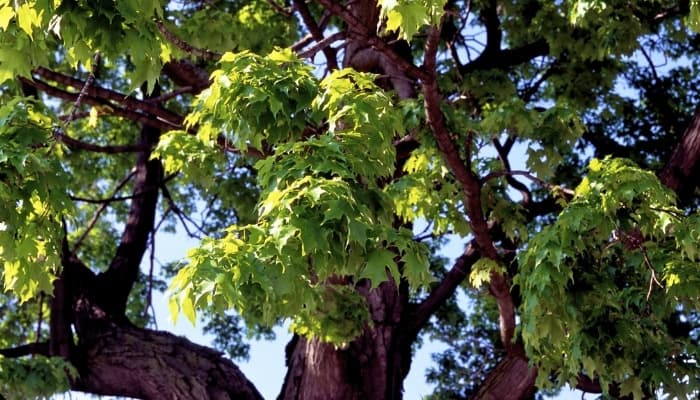
Silver maples are fast-growing deciduous trees found in swamps and moist woodlands and typically thrive in Zones 3-9.
How To Identify
- Bark is grayish brown mottled with gray specks that peels off in thin patches, exposing reddish-brown scaly plates as it matures.
- Trees have a tall vase-shaped canopy with a wide crown and low-to-the-ground branches.
- The 3-6 inch long leaves are maple like but with deeper lobes with very dark-green topsides and hairy, silvery-gray undersides.
- In fall, the foliage turns a greenish-yellow to golden-brown shade.
- Silver maples reach between 50 and 80 feet high and form clumps of rounded crimson flower buds that look like mini cricket balls, sending out tiny red blooms between March and May.
7. Eastern Redbud
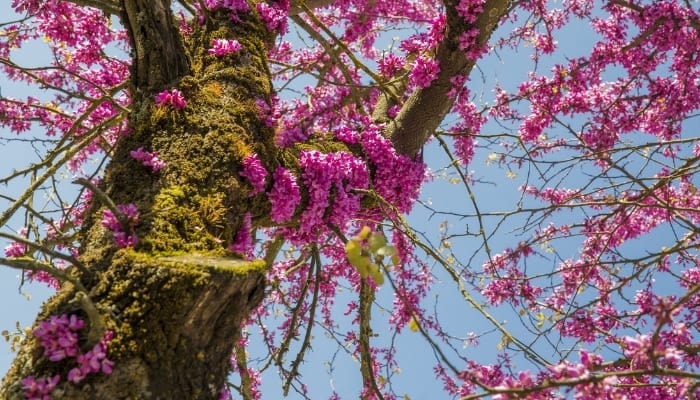
These small deciduous trees thrive in Zones 4-9 and are often found on valley slopes and within moist hardwood forests.
How To Identify
- Bark is initially dark brown and smooth before becoming and ridged ray with age, peeling off in thick scaly patches to expose maroon and orange plates beneath.
- Trees have a rounded, wide-spreading habit with slender, arching branches.
- Its lush-green leaves are broad and heart shaped, measuring around 5 inches long and wide. These turn dark green before adopting a bronze-yellow hue in the fall.
- Eastern redbuds reach just 20-30 feet high with a 30 foot spread and send out beautiful rose/purple pea-like blooms between March and April.
8. Scots Pine
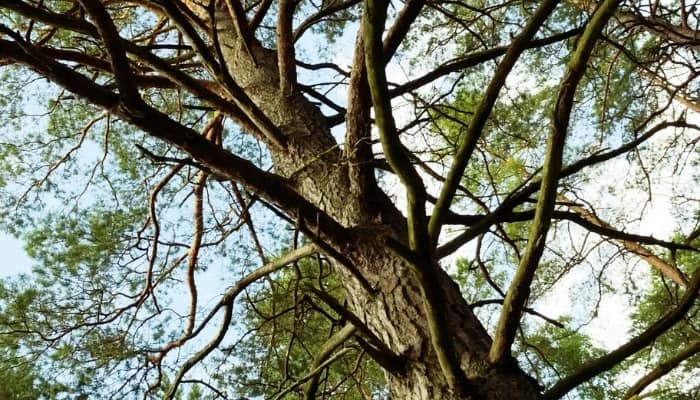
These evergreen conifers are found in pine forests and heathlands and tend to grow best in Zones 3-7.
How To Identify
- Youthful bark is paper thin and burnt orange before aging to a reddish-gray hue and developing deep fissures and scaly lichen growth. Upper bark flakes off with age, revealing smoother green and brown inner bark.
- Trees grow in an open, often irregular pyramid habit with an open crown of horizontal branches nearly parallel to the ground.
- Foliage consists of many blueish-green needles arranged in spiraling pairs that measure 1-3 inches long. These turn yellowish green in fall but don’t all shed simultaneously.
- Scots pines reach 50-60 feet high and produce clusters of yellowish-green balls or “pollen cones” in May, which brown and ripen in late summer as pine cones.
9. Paperbark Maple
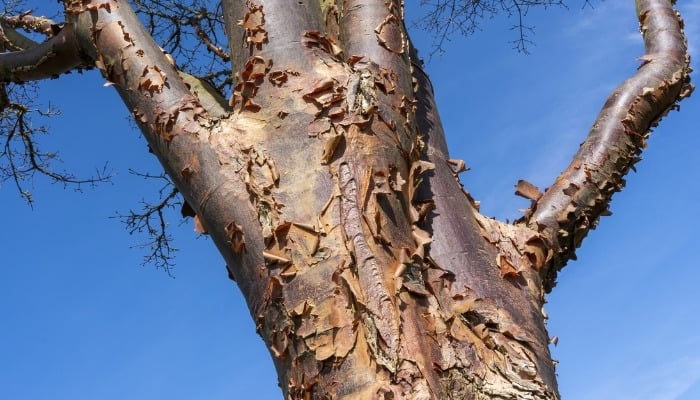
Paperbark maples are small deciduous trees found in moist woods and sheltered regions and are known to thrive in Zones 4-8.
How To Identify
- Bark is initially smooth and cinnamon brown before peeling off in large ringlets, creating a rugged texture and exposed lighter-brown strips beneath.
- Trees are slender with an upright, rounded to oval-shaped habit.
- Leaves are 3-6 inches long and dark green with three distinct lobes, softly serrated edges, and gray-green undersides.
- In fall, the foliage transforms into bold yellow, red, reddish green, and burgundy.
- These trees reach between 20-30 feet high and send out insignificant dangling yellow blooms around April-May.
10. Red Maple
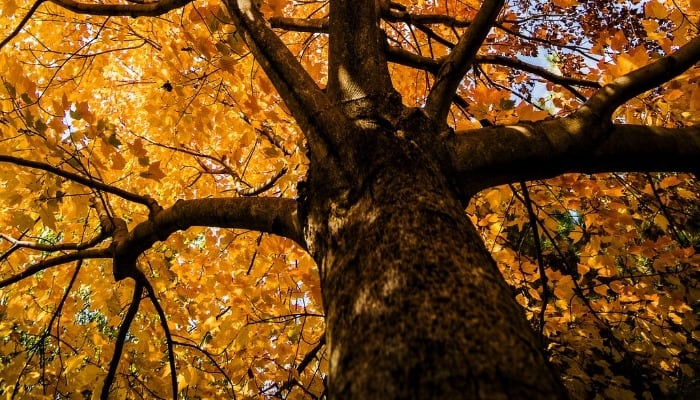
These deciduous trees thrive in Zones 3-9 and are typically spotted in swamplands and along marshes and dry ridges.
How To Identify
- Youthful bark is light, almost silvery-gray and smooth before darkening with age and developing deep vertical cracks, causing the bark to peel off in rough scaly plates.
- Trees move from a pyramidal habit to a rounded canopy overtime with branches spreading evenly in opposite directions.
- The pale-green five-lobed leaves have slightly serrated edges and measure 2-5 inches across. These adopt bold red, orange, and yellow shades in the fall.
- Red maples grow to be 60-90 feet high and produce clusters of tiny pinkish-red flowers dangling from the branches around March-April.
11. Chinese Elm
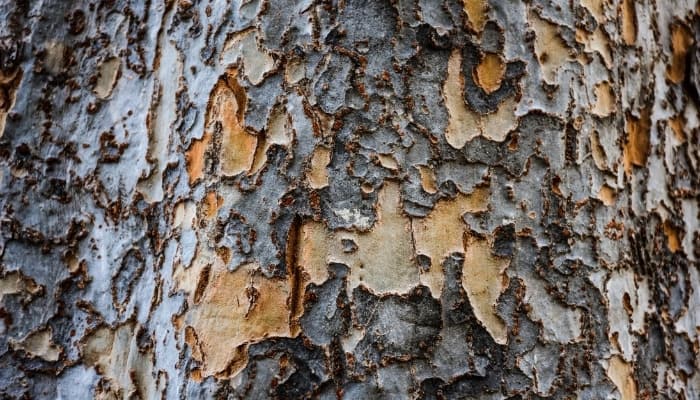
Chinese elms are semi-deciduous and cope best in Zones 5-9. They’re normally found in temperate and tropical-montane forest regions.
How To Identify
- The bark is a dark mottled gray that flakes away with age to reveal a stunning lace-like pattern of gray, green, and burnt-orange bark patches beneath.
- Trees have a wide, elegant canopy shape with gracefully arched branches.
- Its ovular dark-green leaves have a glossy, leathery texture with distinctive ridged veins and measure 1-2 inches long.
- Foliage takes on red, yellow, and purple tones in the fall.
- Chinese elms reach between 40-50 feet high with a similar spread and produce clusters of tiny white flowers in late summer.
12. Crepe Myrtle
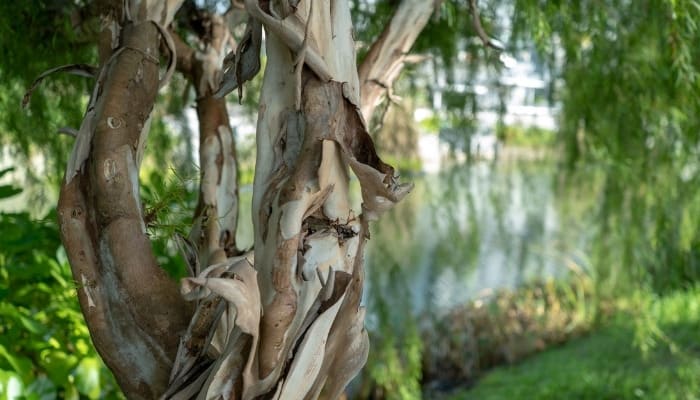
Small and deciduous crepe myrtle trees thrive in Zones 7-10 and are usually found growing on grasslands, forest edges, and along cliffs and riverbanks.
How To Identify
- Bark begins smooth and grayish to light brown before shedding in large thin flakes, creating a distinctive mottled texture that reveals shades of tan, brown, cream, lavender, and dark gray.
- Trees have a bushy, rounded habit with a vase-shaped crown and upward-reaching branches.
- The rounded oval leaves are 1-3 inches long with a deep-green velvety appearance.
- By fall, the foliage takes on bright or intense rich tones of red, orange, and yellow depending on the variety.
- Crepe myrtle trees grow to be 15-25 feet high and produce clusters of white/pink/purple five-petal flowers with ruffled margins lasting from June to early fall.
Conclusion
Whoever coined the phrase “the bark is worse than the bite” clearly never gazed upon these stunningly diverse trees!
As you can see, trees with a shaggy bark run the gamut from scaly trunks with deep ridges and channels to ones peeling delicately until they’re covered in graceful, paper-thin ringlets.
The contrasting colors and patterns uncloaked beneath are another reason to love trees with a rougher bark.

